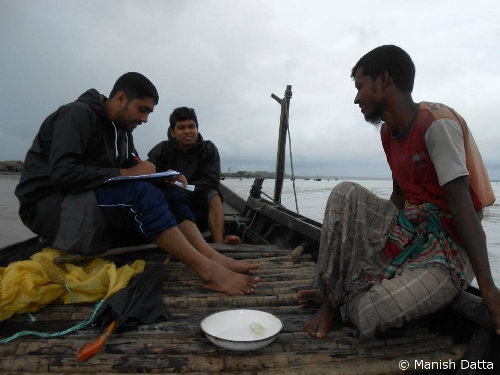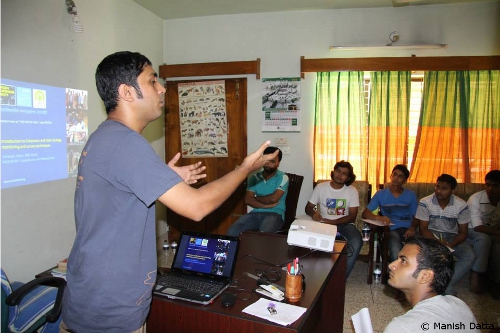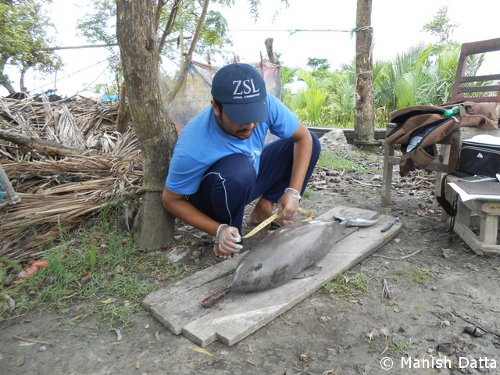Manish Datta is an EDGE fellow working on the South Asian river dolphin in Bangladesh. In his first EDGE blog he describes his love for the species and introduces his EDGE project:
A local myth says that a bashful village woman who was bathing in the river swam into deeper water when an elderly person approached, and never appeared again. She is said to have turned into a Shushuk, a common name for the South Asian river dolphin. Being a part of our daily life in riverine Bangladesh, there are several other stories about this unique river dolphin.
Unfortunately a variety of anthropogenic and environmental issues are threatening our rivers and our freshwater dolphins. The dolphins cryptic surfacing is sadly becoming a rare sight in most of our waterways. Luckily the tidal rivers and creeks in the Sundarbans Reserve Forest are less disturbed by human activities, and therefore considered safer for a number of threatened animals, including South Asian river dolphins and Irrawaddy dolphins. In an attempt to protect the comparatively large numbers of these freshwater dolphins in the only place where they occur together, the Government of Bangladesh recently declared three new Wildlife Sanctuaries in river segments with the highest occurrence of Shushuks in the Eastern Sundarbans.
As the waters adjacent to the Sundarbans are heavily fished, the number of deadly fishing gear entanglementsis presumed to be particularly high in this region. Additional information concerning the use and consumption of dolphin productsin fishing communities around the Sundarbans is alarming. These arising threats to a dwindling population of threatened river dolphins prompted my interest in finding ways to reduce entanglements and stop the use of dolphin products in collaboration with conservation scientists, resource managers and fisher folk.
Through my EDGE fellowship I am studying the characteristics of Shushuk entanglements to identify patternsin the use of dolphin products. Last month I conducted a pilot survey to evaluate my social survey methodology in 4fish landing sites as well as one of the new Wildlife Sanctuaries in the north-eastern fringe of the Sundarbans mangrove forest.Together with 3 trained students I interviewed 200 people.
During the past month we received three reports of dolphin entanglements, to which I responded as part of my research program. Among the incidents one happened on the bordering portion (Keyabunia, Chilla) of the river from one of the sanctuary and other was a report of consumption (at Kankrabuna, Laodobe)of shushuk meat after the entanglement.
I can still recall the day, when I considered this species nothing other than a fish and it was not very far back. The scenario is common for most the Bangladeshi people specially for the village people. A huge portion of the people lives around the rivers and the creeks of the Sundarbans where the species occur most in our country; don’t even know this is a species of dolphin till now. So making people aware about this species is another key issue of this research.
As a part of the CEPA (Communication, Education and Public Awareness), different educational and non government organizations who are working in the study area have been contacted. I further arranged and lead an intensive two-day workshop for 21 bachelor students from three local educational institutes i.e. Khulna University, Khulna Govt. B.L. collage and Khan Jahan Ali technical institute. In addition to training them in social survey methods and preparing them for the pilot survey, where the most promising participants would act as my assistants, I also introduced the mortality response protocol to enable them to assist me in collecting the vital information from dead Shushuks.
Unlike it’s marine cousins this species is less familiar may be for it’s non-charismatic and unsocial nature and people are little aware of their status. I would work for making people aware throughout my fellowship duration so to keep these ‘shy ladies’ in our water.


